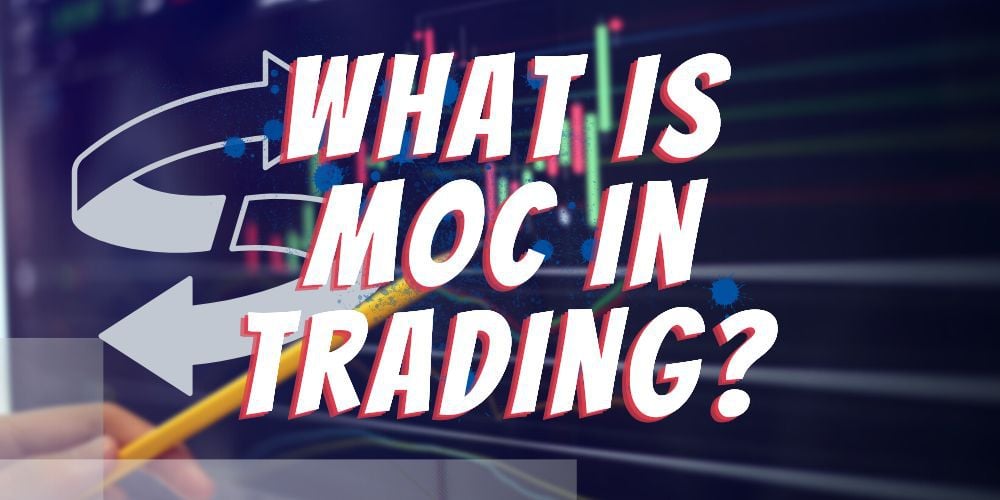Traders are looking for the best way to create their orders. While most know about market and limit orders, there is little information about MOCs.
So, what is MOS in trading? This article explains MOC in trading, when it should be used, and its pros and cons.
What Is MOC in Trading?
The term MOC stands for “Market-on-Close.” It is a buy or sell order executed as near as possible to the closing price of the financial instrument on that trading day.
While placing a Market-on-Close, you might notice that the word “market” appears in the limit price field. This is because MOC is a type of non-limit order.
The world market in the limit price field indicates that the trader is willing to accept whatever price is available at the close of the day.

MOC orders are executed daily, either precisely on or just after the end of trading.
They capture the last possible price level on a given day for the investor. Most often, they are used with a particular trading strategy in mind.
For example, the trader might try to ensure that a stock is bought or sold on the day, but only when a certain price level is breached.
Finally, a variant of MOC is the “Market-on-Open” order, which executes on the opening price or just after the start of trading instead.
About Market-on-Close (MOC) Orders
A MOC order remains dormant until just before the market closes for trading.
Once active, it behaves just like standard market orders.
The security is bought or sold at the current market price (which happens to be the closing price).
There are some things to remember about MOCs.
Firstly, they are not available in all markets or from all brokers, though most major stock exchanges do have them.
Moreover, there is usually a cut-off time until they can be placed or modified.
For example, the NYSE markets rules require them to be created before 3:45 pm EST. Nasdaq rules let traders set them up by 3:50 pm EST.
After this time, neither exchange allows new MOC orders or the cancelation of existing ones.
What Is MOC Imbalance?
When the buy or sell orders outweigh the other at the end of the day, it creates a MOC imbalance.

In this scenario, if an investor wants to add a new MOC, they must place it on the opposite side of whichever side is dominant.
For example, if there are more buy orders, then a trader can only place sell MOCs, and vice versa.
Pros of Market-on-Close Orders
Market-on-Close orders are particularly useful when investors suspect that large price movements might happen overnight after the closure of the day.
For example, a firm might have a buyout buzz that is expected to be announced. Another case is a make-or-break investor call about to happen the next day.
In such situations, MOCs help the trader get the best price before the aftermarket activity begins.
Another place where MOCs are helpful is if the investor knows they won’t be able to execute a very important buy or sell instruction.
For instance, they may want to ensure they will exit their current position at the end of the day.
If they cannot place a market order immediately at the close of the day, this type of order can come to the rescue.
Another case exists when positions on foreign exchanges need to be closed out.
Sometimes, doing it yourself will be difficult due to the difference in time zone. A MOC order will automatically do the job at the closing market price.
Cons of Market-on-Close Orders
MOC orders have two main drawbacks: the trader is unsure of the price they will get, and end-of-day fluctuations might cause poor execution.
The first issue is that if the trader isn’t around at the close of the day, they don’t know the price level at which they buy or sell in a MOC.
It gets executed automatically, and there is no control over the price.
Secondly, end-of-day price fluctuations are quite common on stock exchanges.
MOC orders can execute at a lousy price point during such volatility.
Lastly, these orders risk being executed adversely by end-of-day trading clusters.
This happens when there are a lot of pending orders in the stock market at the close of the day. It is a rare scenario, but it can happen sometimes.
Can Market on Close Orders Be Cancelled?
Yes, MOC orders can be canceled, but only before the time specified by the stock market where they are set up.

For example, on the NYSE, this has to be done before 3:45 pm EST, and on the Nasdaq, it must be completed before 3:50 pm EST.
After 4 pm EST, traders can neither change nor cancel these orders on either exchange.
What Is LOC in Trading?
LOC stands for Limit-on-Close. It is a specific type of MOC order that only executes if the closing price is near the limit price set by it.
The difference between a regular limit order and a LOC is that the latter executes only at the close of the day.
LOCs offer all the benefits of Market-on-Close orders, with added control on execution price.
However, their big disadvantage is that they may or may not execute, unlike MOCs, which are always carried out.
Final Thoughts
A Market-on-Close order helps traders capture the best price before the market shuts down and aftermarket activity begins.
Investors can use them when they are certain of exiting their position at the closure of the day but may not be able to place the market order themselves.
The main drawback of a MOC is that there is no visibility on the final price at which the buy or sell instruction will happen.
One workaround to this problem is to use Limit-on-Close orders instead, which has its problems, as outlined above.
Lastly, end-of-day fluctuations may cause the trade to execute poorly.
Investors should weigh the pros and cons of MOC orders before using them.


 Tags:
Tags:










